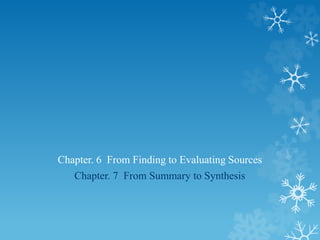
Chapter Six & Seven November 6th 2012
- 1. Chapter. 6 From Finding to Evaluating Sources Chapter. 7 From Summary to Synthesis
- 2. Chapter. 6 From Finding to Evaluating Sources
- 3. Identifying Sources Consult Experts Who Can Guide Your Research: (1) Your Writing Instructor. (2) Librarians at your campus or local library. (3) Experts in other fields. (4) Manuals. handbooks, and dedicated websites.
- 4. Distinguish Between Primary & Secondary Sources Primary source- a firsthand, or eyewitness, account, the kind of account you find in letters or newspapers or research papers in which the researcher explains his or her impressions of a particular phenomenon. Secondary source- an analysis of information reported in a primary source. See table 6.1 p. 123-124.
- 5. Distinguish Between Popular & Scholarly Sources Popular sources- information from sources such as newspapers or large circulation magazines. Scholarly sources- are written for experts in a particular field. Subject driven materials that are created by experts in the same field, which design their materials for colleagues or those in similar fields of interest: (1) Peer review- scholarly materials will not get published until they have been carefully evaluated by the author’s peers, other experts in the academic conversation being conducted in the journal. Table 6.2 p. 126.
- 6. Searching For Sources Keyword search. Try browsing. Perform a journal or newspaper title search.
- 7. Evaluating Library Sources The author’s background and credentials. The writer’s purpose. The topic of discussion. The audience the writer invokes and whether you are a member. The nature of the conversation. What the author identifies as a misinterpretation or a gap in knowledge or an argument that needs modifying. What the author’s own view is. How the author supports his or her argument. The accuracy of the author’s evidence.
- 8. Skimming Skimming- briefly examining the material to get a sense of the information it offers. 4 steps: (1) Read the introductory sections. (2) Examine the table of contents and index. (3) Check the notes and bibliographic references. (4) Skim deeper.
- 9. Evaluating Internet Sources Evaluate the author of the site. Evaluate the organization that supports the site. Evaluate the purpose of the site. Evaluate the information on the site.
- 10. Chapter. 7 From Summary to Synthesis
- 11. Summaries, Paraphrases, & Quotations Paraphrase- a restatement of all the information in a passage in your own words, using your own sentence structure and composed with your own audience in mind to advance your argument (p.140-141 eg). Steps to writing a paraphrase: (p. 143) (1) Decide whether to paraphrase. (2) Understand the passage. (3) Draft your paraphrase.
- 12. Summaries, Paraphrases, & Quotations (2) Summary- condenses a body of information, presenting the key ideas and acknowledging their source. Summarizing methods: (1) Describing the author’s key claims. (a) Notice how paragraphs begin and end. (b) Notice the author’s point of view and transitions. (2) Select examples to illustrate the author’s argument. (3) Present the gist of the author’s argument. (a) Gist- expressing the author’s central idea in a sentence or two. (4) Contextualize what you summarize (Fig 7.1/p. 150).
- 13. Synthesis VS Summary Synthesis- a discussion that forges connections between the arguments of two or more authors. Requirements for synthesizing: (1) Make connections among ideas in different texts (p. 165). (2) Decide what those connections mean (p. 166). (3) Formulate the gist of what you’ve read (Fig 7.2/p. 166-168).
- 14. Integrating Quotations Into Your Writing There are 3 things one must consider when integrating quotations: (1) Take an active stance- means knowing when to quote. Don’t quote when a paraphrase or summary will convey the information from a source more effectively. (a) It’s not fair to quote selectively-choosing only passages that support your argument-when you know you are distorting the argument of the writer you are quoting. You want to show that you understand the writer’s argument, and you don’t want to make evenhanded use of it in your own argument. (b) It’s not wise to fill up your paper with an overwhelming amount of quotations that could lead readers to believe that you don’t know your topic well, or don’t have your own ideas.
- 15. Integrating Quotations Into Your Writing (2) (2) Explain the Quotations- when you quote an author to support or advance your argument, make sure that readers know exactly what they should learn from the quotation (p. 183-184). (3) Attach Short Quotations to Your Sentences- make shorter quotations part of your own sentences so that your readers can understand how the quotations connect to your argument and can follow along easily. There are two main methods to do this: (a) Integrate quotations within the grammar of the sentence- the quotation must make grammatical sense and read as if it is part of the sentence (p. 185). Ellipsis-use when you omit any words in the middle of a quotation. (b) Attach quotations with punctuation- one can also attach a quotation to a sentence by using punctuation (p. 185-186). DO NOT USE: Block Quotations- lengthy quotations of more than five lines that are set off from the text of a paper with indention.
- 16. End Chapter. 7
